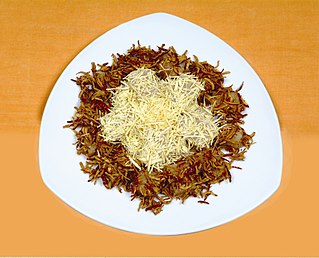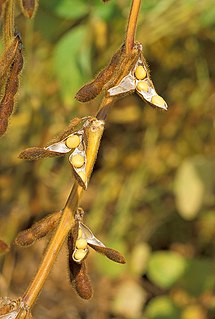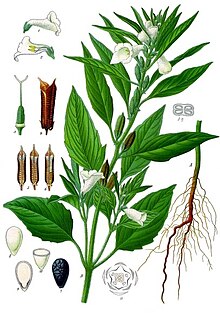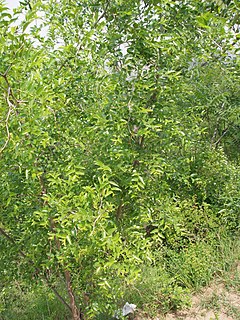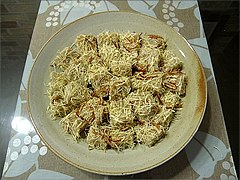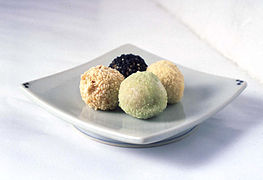
Korean royal court cuisine was the style of cookery within Korean cuisine traditionally consumed at the court of the Joseon Dynasty, which ruled Korea from 1392 to 1910. There has been a revival of this cookery style in the 21st century. It is said that twelve dishes should be served along with rice and soup, with most dishes served in bangjja (bronzeware).
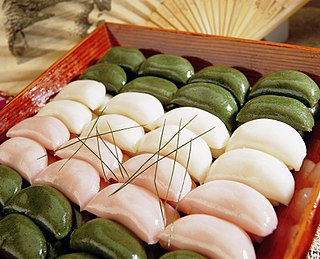
Songpyeon (송편) is a traditional Korean food made of rice powder. It is a type of tteok, small rice cakes, traditionally eaten during the Korean autumn harvest festival, Chuseok. It became a popular symbol of traditional Korean culture. The earliest records of songpyeon date from the Goryeo period.
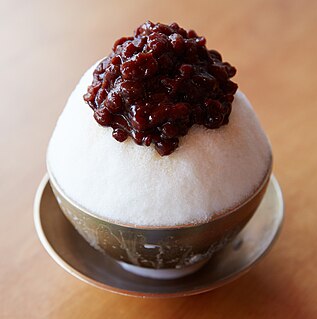
Patbingsu is a popular Korean shaved ice dessert with sweet toppings that may include chopped fruit, condensed milk, fruit syrup, and red beans. Varieties with ingredients other than red beans are called bingsu.

A rice cake may be any kind of food item made from rice that has been shaped, condensed, or otherwise combined into a single object that has also been sweetened. A wide variety of rice cakes exist in many different cultures in which rice is eaten, and are particularly prevalent in Asia. Common variations include cakes made with rice flour, those made from ground rice, and those made from whole grains of rice compressed together or combined with some other binding substance.

Bindae-tteok (빈대떡), or mung bean pancake, is a type of buchimgae that originated in the Pyongan Province. It is made by grinding soaked mung beans, adding vegetables and meat and pan-frying it into a round, flat shape.

Suksil-gwa, literally "cooked fruit", is a category of hangwa consisting of cooked fruit, roots, or seeds sweetened with honey. Common ingredients include chestnut, jujube, and ginger. Suksil-gwa is similar to—and sometimes classified as—jeonggwa, but has unique characteristics that differentiate it from the jeonggwa category.

Sirutteok (시루떡) is a type of Korean rice cake (tteok) traditionally made by steaming rice or glutinous rice flour in a "siru" (시루), a large earthenware vessel used for steaming which gives "sirutteok" its name. "Sirutteok" is regarded as the oldest form of tteok in Korean history.
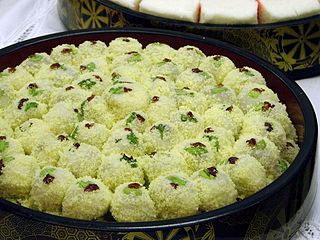
Bupyeon (부편) is a type of steamed tteok, used in traditional weddings. It is a local specialty of Miryang, South Gyeongsang Province.

Gaepi-tteok (개피떡) or baram-tteok (바람떡) is a half-moon-shaped tteok made with non-glutinous rice flour and filled with white adzuki bean paste.
Korean regional cuisines are characterized by local specialties and distinctive styles within Korean cuisine. The divisions reflected historical boundaries of the provinces where these food and culinary traditions were preserved until modern times.

Gyeongdan (경단) or Korean rice ball cake is a type of tteok made of glutinous rice or other glutinous cereal flours. When the cereal other than rice is used, its name is usually specified, making compound nouns such as susugyeongdan. The name chapssalgyeongdan may also be used, but chapssal can be, and usually is, omitted.
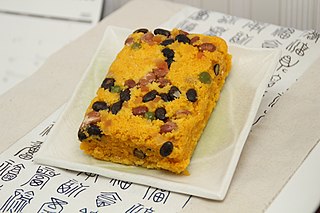
Hobak-tteok (호박떡) is a variety of siru-tteok made by mixing fresh or dried pumpkin with glutinous or non-glutinous rice flour, then steaming the mixture in a siru.

Mu or Korean radish is a variety of white radish with a firm crunchy texture.




